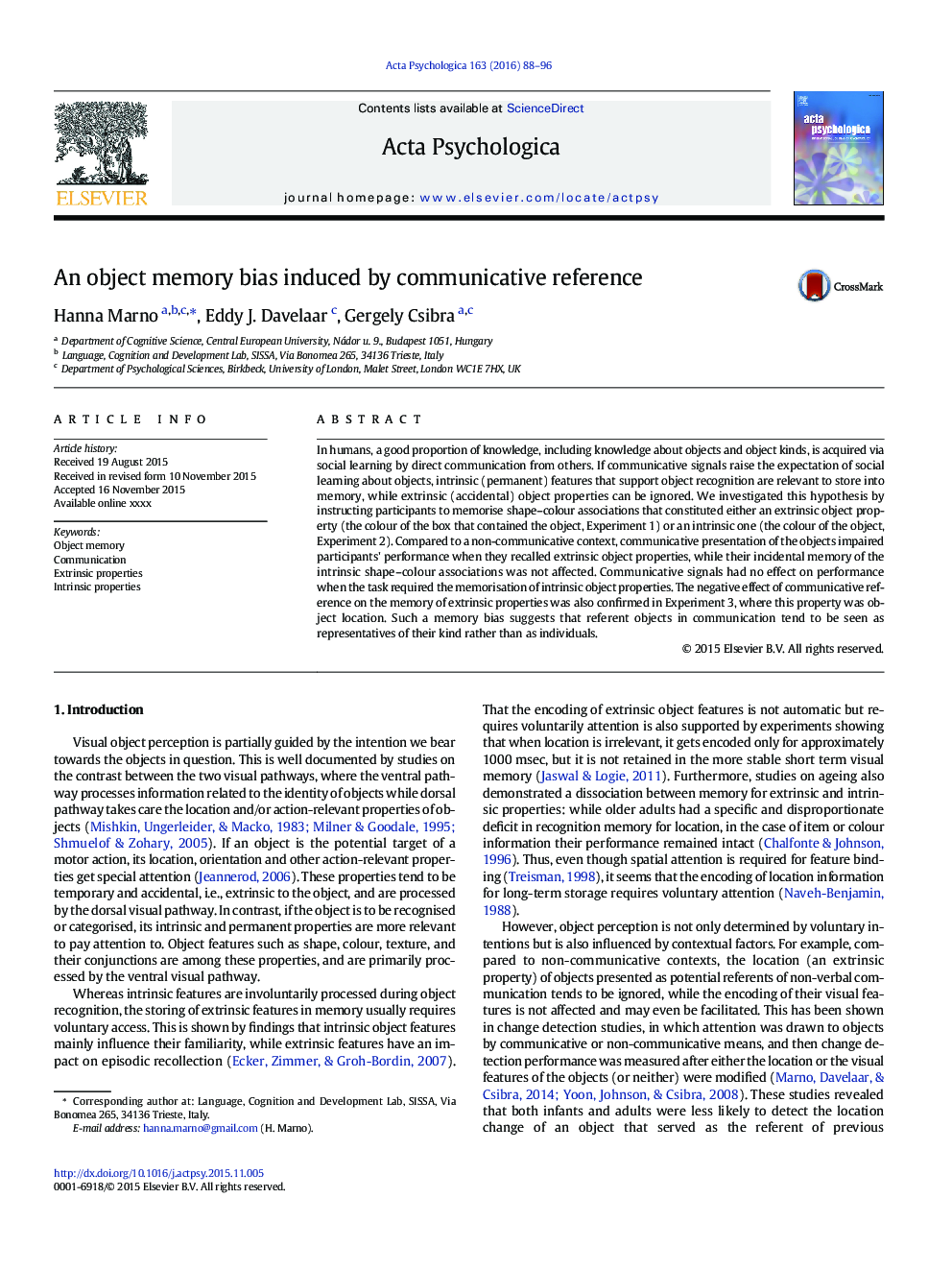| کد مقاله | کد نشریه | سال انتشار | مقاله انگلیسی | نسخه تمام متن |
|---|---|---|---|---|
| 7277145 | 1473595 | 2016 | 9 صفحه PDF | دانلود رایگان |
عنوان انگلیسی مقاله ISI
An object memory bias induced by communicative reference
ترجمه فارسی عنوان
تعویض حافظه ی شیء ناشی از مرجع ارتباطی
دانلود مقاله + سفارش ترجمه
دانلود مقاله ISI انگلیسی
رایگان برای ایرانیان
کلمات کلیدی
حافظه شی، ارتباطات، خواص بیرونی، خواص ذاتی،
ترجمه چکیده
در انسان، نسبت خوبی از دانش، از جمله دانش در مورد اشیاء و انواع شیء، از طریق یادگیری اجتماعی بوسیله ارتباط مستقیم از دیگران به دست می آید. اگر سیگنال های ارتباطی، انتظارات یادگیری اجتماعی درباره اشیاء را افزایش دهند، ویژگی های ذاتی (دائمی) که از تشخیص ابعاد پشتیبانی می کنند، مربوط به ذخیره در حافظه می باشند، در حالی که خواص بیرونی (تصادفی) شیء می تواند نادیده گرفته شود. ما این فرضیه را با در اختیار قرار دادن شرکت کنندگان در حفظ ترکیبات شکل-رنگ، که یک ویژگی شیء بیرونی (رنگ جعبه حاوی شیء، آزمایش 1) یا یک درون ذاتی (رنگ شی، آزمایشی 2) بود، مورد بررسی قرار دادیم. در مقایسه با یک زمینه غیر ارتباطی، ارائه ارتباطات از اهداف شرکت کنندگان را مختل می کند زمانی که خواص شیء بیرونی را فراخوانی می کردند، در حالی که حافظه اتفاقی آنها از ترکیبات رنگ شکل ذاتی نبودند. سیگنال های ارتباطی بر کارایی تاثیری نداشت، وقتی که وظیفه حفظ حافظه خواص ذاتی بود. اثر منفی مرجع ارتباطی در حافظه خواص بیرونی نیز در آزمایش 3 تأیید شد، جایی که این ویژگی محل سکونت بود. چنین تعصب حافظه نشان می دهد که مفاهیم ارجاع در ارتباط، به عنوان نماینده نوع خود به جای آن به عنوان فردی دیده می شود.
موضوعات مرتبط
علوم زیستی و بیوفناوری
علم عصب شناسی
علوم اعصاب شناختی
چکیده انگلیسی
In humans, a good proportion of knowledge, including knowledge about objects and object kinds, is acquired via social learning by direct communication from others. If communicative signals raise the expectation of social learning about objects, intrinsic (permanent) features that support object recognition are relevant to store into memory, while extrinsic (accidental) object properties can be ignored. We investigated this hypothesis by instructing participants to memorise shape-colour associations that constituted either an extrinsic object property (the colour of the box that contained the object, Experiment 1) or an intrinsic one (the colour of the object, Experiment 2). Compared to a non-communicative context, communicative presentation of the objects impaired participants' performance when they recalled extrinsic object properties, while their incidental memory of the intrinsic shape-colour associations was not affected. Communicative signals had no effect on performance when the task required the memorisation of intrinsic object properties. The negative effect of communicative reference on the memory of extrinsic properties was also confirmed in Experiment 3, where this property was object location. Such a memory bias suggests that referent objects in communication tend to be seen as representatives of their kind rather than as individuals.
ناشر
Database: Elsevier - ScienceDirect (ساینس دایرکت)
Journal: Acta Psychologica - Volume 163, January 2016, Pages 88-96
Journal: Acta Psychologica - Volume 163, January 2016, Pages 88-96
نویسندگان
Hanna Marno, Eddy J. Davelaar, Gergely Csibra,
